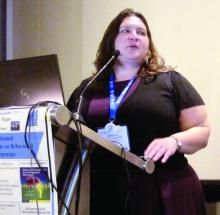WASHINGTON – Imagine desperately wanting addiction treatment while living in a homeless shelter with many people who were using drugs. Could you remain sober for 6 weeks until treatment was available at an outpatient clinic – or would you bluff your way into treatment in an emergency department, where you would receive follow-up care within a week?
This is the kind of challenge that Margaret Balfour, MD, PhD, said she puts to her staff – and to anyone who treats patients they suspect are lying about this medical conditions. “Could [you], as a well-adjusted professional with reasonably good coping skills tolerate the things we ask our patients to do in order to help ‘appropriately’ ” asked Dr. Balfour, chief clinical officer at the Crisis Response Center in Tucson, Ariz., and a vice president for clinical innovation and quality at ConnectionsAZ in Tucson and Phoenix.
As one of several panelists in a session dedicated to detection and deterrence of malingering – defined in the DSM-5 as the “intentional production of false or grossly exaggerated physical or psychological symptoms, motivated by external incentives” Dr. Balfour made her comments at the annual American Psychiatric Association’s Institute on Psychiatric Services.Signs of malingering
On average, 13% of the people presenting in the ED malinger, according to panelist Scott A. Simpson, MD, MPH, of the department of psychiatry at the University of Colorado at Denver, Aurora, and the medical director of psychiatric emergency services at Denver Health. So, how can a clinician differentiate whether a patient’s story is fact or fiction, and what can be done to get the real story?
Classic signs of malingering include a notable discrepancy between observed and reported symptoms, reports of atypical psychosis, and inexplicable cognitive symptoms. “Watch for things that seem odd, such as late-in-life onset of psychosis, Dr. Simpson said.
One of the main ways to identify malingering is to use mental status and other exam; however, laboratory and neuropsychological tests have more limited roles. Lie detection tests specifically are very difficult to administer in the clinical setting, making them impractical.Patients who grow increasingly irritated during the patient interview, even to the point of threatening suicide if their treatment demands aren’t met, also can be patients who malinger However, some data do not necessarily support this as cause for alarm, according to Dr. Simpson, who cited a study showing that among 137 patients who endorsed suicidality, the 7-year suicide rate among those who did so conditionally was 0.0%, compared with 11% in those who did not have conditional suicidality (Psychiatr Serv. 2002 Jan;53[1]:92-4). The overall 7-year mortality in the first cohort was 4%, compared with 20% in the latter.
Rather than panic in such a situation, go deeper, said panelist John S. Rozel, MD, of the department of psychiatry at the University of Pittsburgh, where he also completed a master of studies in law program and serves as an adjunct professor of law. Dr. Rozel also is the medical director of the university’s re:solve Crisis Network.
“Maybe the person is worried they won’t be taken seriously,” said Dr. Rozel, explaining why some patients will escalate their claims and often are oblivious to their deceit. He shared an anecdote of having been called to treat a 14-year-old trauma patient with suicidality but who didn’t endorse any thoughts of self-harm during the patient interview. Instead, she told him that being suicidal is“what you say when you need more support, and the staff aren’t paying enough attention to you.”
Documenting the behavior
Even when clinicians are sure their patient is malingering, they often are reluctant to document it, according to Rachel Rodriguez, MD, an inpatient/emergency attending psychiatrist at Bellevue Hospital Center in New York.
“Malingering is lying, and lying is distasteful. It’s difficult to talk about,” Dr. Rodriguez said. “It’s also making a judgment about someone’s intentions, which is outside the bounds of what we are trained to do.”
Clinicians are reluctant to formally identify malingering for many reasons, Dr. Rodriguez said in an interview. Those reasons include:
• Future denial of necessary care.
• Fear of retaliation.
• Concerns about making a judgment about motives/intentions.
• Risk of misidentification.
• Fear of liability.
• Feeling sorry for the patient and helpless to address the patient’s actual needs.
Dr. Rodriguez said the underidentification and overidentification of malingering also include unique sets of risks.
At the session, Dr. Rozel agreed that an unwillingness to address malingering head-on does have its risks.
“Documentation is very important in medical malpractice. If we [record] our thinking in our notes, it’s kind of like high school math; you at least get partial credit if you show the work.” Thorough note taking includes recording the observations of all the personnel involved in the patient’s case, according to Dr. Rozel. As an example, he shared an anecdote of a patient endorsing suicidal symptoms in the interview with the clinician, but flirting with others in the waiting area, as witnessed by the admitting nurse.
Based on your observation and on a review of your patient’s prior history, Dr. Rozel suggested this partial list of notes and phrasing can be effective at establishing a “clear paper trail” should there need to be one:



